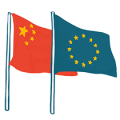

Europe has to buckle up to survive the challenge of the “Belt and Road”
As Chinese companies become ever more assertive globally, Europe needs to better support up-and-coming industries and advance cross-regional partnerships, argue Alexandra-Andreea Pop and Anne-Sophie Deman.
This article is part 3 of a mini-series to present the outcomes of the MERICS European China Talent Program 2019.
Europe’s efforts to foster homegrown companies in emerging industries and protect market share in traditional sectors are being challenged by agile newcomers from an ambitious and resourceful China. As the next head of the European Commission, Ursula von der Leyen, has to ensure Europe’s leaders agree on how to master this challenge. She and her colleagues must secure domestic and global markets for European companies - old, new, and yet to be invented ones – at a time when the European economic model is being challenged.
Chinese companies have chipped away at Europe’s leadership position in many sectors
The clock is ticking. Europe missed the digital revolution of the 2000s – China did not. Today, European companies hold only three per cent of global online-platform market share. Chinese giants Tencent, Alibaba, and Ant Financial dominate Asia’s almost tenfold share of 27 per cent. While European companies‘ slow digitalization continues to hinder their development, Chinese companies have bought European trophy assets like KUKA, Syngenta or Volvo, and chipped away at Europe’s position as a global leader in many sectors, from automation to chemicals.
This trend became painfully obvious in 2013. China shook things up again by showing it was ready to open its wallet to revive the Silk Road. The project supports Chinese firms to go abroad, while exporting overcapacities at home and bringing partners near and far into a more Sino-centric economic order. Two years later, it called upon its industry to secure China’s seat at the table of global industrial and technological leaders. The “Made in China 2025” plan is meant to upgrade the Chinese economy and ensure China’s high-tech self-sufficiency and global market dominance.
European leaders must swiftly rethink the EU’s internal and external priorities
As China appears to be moving ever faster with its push for smart technologies development like artificial intelligence or robotics, European countries are mired in debates about how best to nurture competitive homegrown companies – a situation some have sought to evade by tapping into China’s Belt and Road Initiative and its promised investment flows that could elevate their economic prospects. To turn things around, European Union leaders must rethink the EU’s internal as well as external priorities - and do so fast. Only then will the EU be able to compete with a determined China and its growing appeal.
The European Union has not been inactive. Under Jean-Claude Juncker, von der Leyen’s predecessor, European leaders agreed collective initiatives in artificial intelligence and battery development to better position the EU as a supplier of emerging technologies. But that alone will very likely prove too little and too late to pose any real challenge to China’s efforts in both fields. If they are serious about their aims, EU leaders – guided by von der Leyen and her new European Commission – need to identify the up-and-coming industries that matter and provide them with timely support. The relaunch of the EU’s industrial policy strategy would be a vital stepping-stone on this path.
It is essential to forge a consolidated EU approach
In general, political will is essential to forge a consolidated EU approach. This must bundle and channel the innovation-boosting initiatives of member states to respond to on-the-ground development needs across Europe -– from upgrading technology to full-blown industrial transition. Taking the right measures to foster local innovation will help to ensure that European companies reap the benefits of digital transformation and remain competitive in established and emerging sectors in fast-changing global markets.
In particular, the EU has to expand and speed up private-public partnerships under the resource-pooling framework called Important Projects of Common European Interest (IPCEIs). It should also establish fine-tuned and more accessible funding tools similar to the InvestEU program to guarantee sustainable investment for promising ideas. A potential European Future Fund could complement this initiative and raise €100 billion more in public and private funding. To allow specialized talent to cluster where it is needed, the EU has to scale up the pan-European network of Digital Innovation Hubs. Currently, this is geared towards small and medium-sized enterprises. It should be expanded to include bigger companies, while also encouraging more collaboration between member states and experts. More information exchange about industrial capabilities and innovation needs will better inform the design of such strategies for industrial development.
China sent its companies into the world to hone their competitive advantages
Regions and countries build competitive companies at home and test their strength against that of competitors abroad. Before finalizing the blueprint for its “Made in China 2025” strategy, China first sent its companies into the world to hone their competitive advantages and assert themselves. Huawei is an example of this approach – as European companies are discovering, Chinese companies are rapidly asserting themselves along its many routes and beyond.
In the end, to ensure European companies stay competitive both at home and internationally, a revamped EU industrial policy strategy should emphasize seizing new opportunities in areas where there is still room - for setting standards, say. In the race with China, the EU connectivity strategy published in 2018 needs to be made more comprehensive and better-targeted to connect with Asia and be a key enabler of this goal. It would not only better channel Europe‘s public and private resources pool towards development opportunities that stimulate innovation on both continents. It would also further promote EU investment in partner countries, raise the profile of existing EU projects that lack nothing in scale but everything in publicity, and establish new partnerships where there are currently none. It is a step Europe urgently needs to take.
The authors participated in the fifth annual MERICS European China Talent Program in May 2019, during which parts of the argumentation presented in this blogpost were developed. The authors bear sole responsibility for the content.
